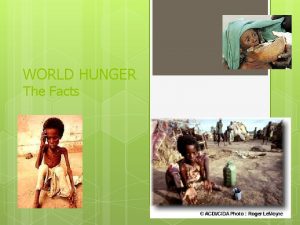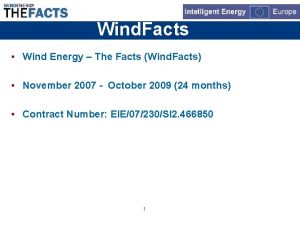Water in our World Water Facts There is













- Slides: 13

Water in our World

Water Facts… � There is the same amount of water on Earth as there was when the Earth was formed. The water from your faucet could contain molecules that dinosaurs drank. � Water is composed of two elements, Hydrogen and Oxygen. 2 Hydrogen + 1 Oxygen = H 2 O. � Nearly 97% of the world’s water is salty or otherwise undrinkable. Another 2% is locked in ice caps and glaciers. That leaves just 1% for all of humanity’s needs — all its agricultural, residential, manufacturing, community, and personal needs. � Water regulates the Earth’s temperature. It also regulates the temperature of the human body, carries nutrients and oxygen to cells, cushions joints, protects organs and tissues, and removes wastes.

Water Facts continued… � 75% of the human brain is water and 75% of a living tree is water. � A person can live about a month without food, but only about a week without water. � Water is part of a deeply interconnected system. What we pour on the ground ends up in our water, and what we spew into the sky ends up in our water. � The average total home water use for each person in the U. S. is about 50 gallons a day. � The average cost for water supplied to a home in the U. S. is about $2. 00 for 1, 000 gallons, which equals about 5 gallons for a penny. � Water expands by 9% when it freezes. Frozen water (ice) is lighter than water, which is why ice floats in water.

Water Filtration & Watersheds � http: //www. epa. gov/safewater/kids/flash/fla sh_filtration. html � http: //www. fcwa. org/education/watershed/in dex. html

The Hydrosphere (layer of H 2 O) � Fresh Water- ponds, rivers, lakes, streams (does not have salt) 3% of Earth’s H 20 � Less than 1% is available for human consumption � Saltwater- Makes up 97% of Earth’s water, can remove salt through Desalination � Erosion- soil and sediment are moved by rivers, wind, snow, ice, etc. � Grand Canyon is a good example � Water Cycle- continuous flow of water � Condensation, precipitation, percolation, runoff, transpiration, storage, and evaporation

Water Cycle Intro (video) � http: //www. epa. gov/safewater/kids/flash/fla sh_watercycle. html

The Water Cycle Condensation -forms precipitation in clouds, gas-> liquid) � Precipitation -rain, ice, snow, hail � Percolation -water moves down in soil)/Infiltration � Runoff -not absorbed->flows in streams over land) � Storage -(water stored in oceans, lakes, etc. ) � Transpiration-water moves through plants, leads to droplets on leaves � Evaporation (absorbed back to clouds, change liquid to gas) �

Water Cycle Info �http: //water. usgs. gov/edu/watercycleoc eans. html �http: //water. usgs. gov/edu/watercycle- kids. html


Vocabulary � Tributary- ocean) � Watershed � Load- water flows into something larger (river, –drainage basin (land where water is drained) deposits carried by water � Deposition- � Delta- sediment dropped in river basin or floor triangular shaped area where sand deposits � Flood plain- area that easily floods (Louisiana, Collettsville) � Water table -able to measure water levels (rises in wet season, drops in dry season)

� � � � Vocabulary Aquifer-rocky layer that holds water underground (Castle Hayne largest in NC) Porosity- (have pores) ability to hold water (like a sponge) Permeability-ability to let water move through rock, Impermeable (rocks that stop the flow) Artesian spring- water that flows from a crack in a rock Point-source pollution- comes from a specific place or site (can be controlled or cleaned) Non-point-source pollution- pollution from many sources (hard to clean up, most common) p. H- amount of acid or base in a liquid (water is around 7, healthy is 6. 5 -8. 5) Turbidity- amount of particles in water (silt, plankton, waste) turbidity, visibility

Concerns � http: //water. epa. gov/learn/kids/drinkingwat er/bloopers. cfm

Resources � http: //thewaterproject. org/community/stud ent-resources/water-related-educationmaterials-for-high-school/ � http: //water. usgs. gov/edu/watercycleocean s. html
 Water and water and water water
Water and water and water water Thinking affects our language, which then affects our:
Thinking affects our language, which then affects our: Our census our future
Our census our future Christ be our light
Christ be our light Marcus aurelius our life is what our thoughts make it
Marcus aurelius our life is what our thoughts make it We bow our hearts
We bow our hearts Our census our future
Our census our future Our life is what our thoughts make it
Our life is what our thoughts make it Summary of the poem money madness
Summary of the poem money madness Our awareness of ourselves and our environment
Our awareness of ourselves and our environment Our awareness of ourselves and our environment
Our awareness of ourselves and our environment God our father christ our brother
God our father christ our brother Our future is in our hands quotes
Our future is in our hands quotes Our awareness of ourselves and our environment.
Our awareness of ourselves and our environment.

























